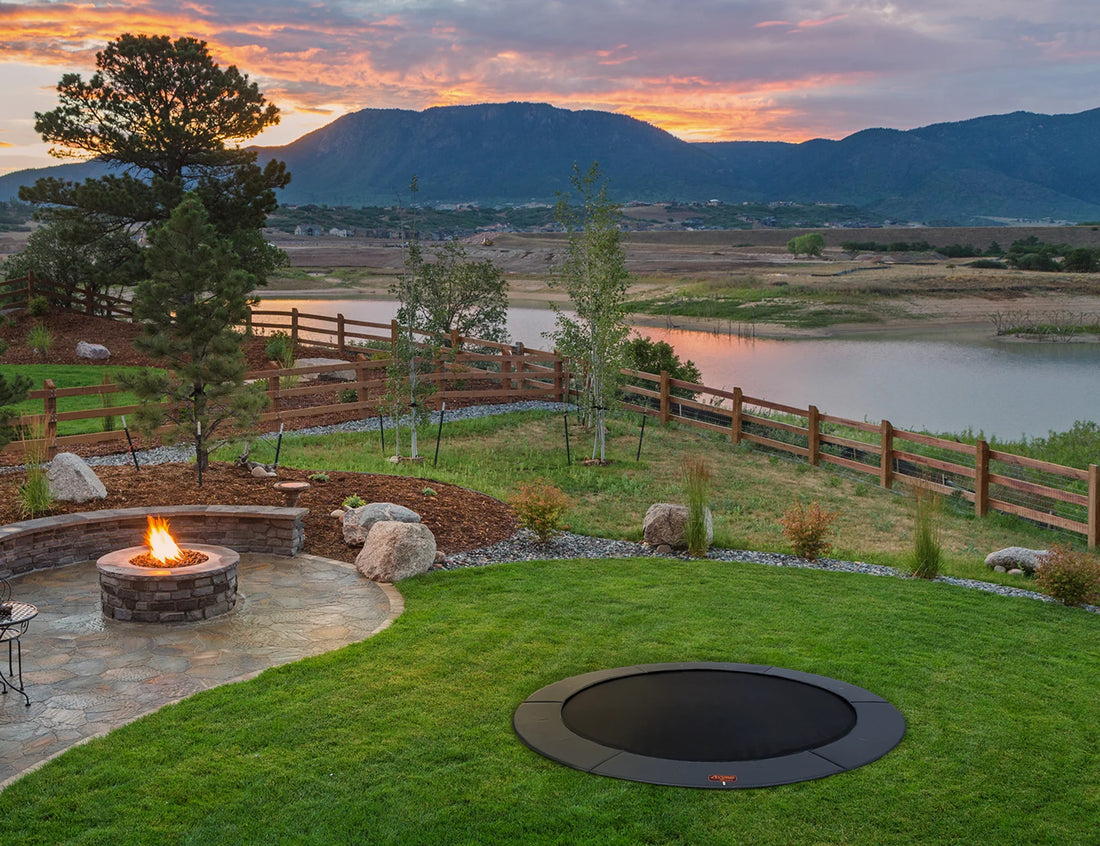Are you dreaming about a beautiful backyard space where you and your children can relax and enjoy some sunshine? There is nothing quite like an inground trampoline to keep your kids active and entertained without using screens. Trampolines don’t require much space or much cost for the amount of fun you can get from one. One challenge for certain would-be trampoline families is that their yards are sloped which makes an inground trampoline install tricky. Let’s discuss how you can set up and enjoy an in-ground trampoline even if your yard is slanted.
Why Choose an Inground Trampoline?
While you can certainly set up a trampoline just sitting on top of your grass, an in-ground trampoline is on another level aesthetically and for safety - it is flush with the ground so you can walk on and off, and it doesn’t obstruct your view in the backyard. Parents love the safety for their kids and the low profile for their own enjoyment of the landscape.
Planning Your Installation
Here are the three steps to planning your installation on a sloped yard:
- Look for the most level spot possible in the yard to minimize the amount of digging.
- If you don’t know what’s under your yard, call 8-1-1 before you dig to make sure you don’t run into any underground utilities.
- Measure the area to ensure it is big enough for your chosen trampoline.
To ensure you always have a trampoline that fits as your kids grow, pick the largest trampoline size that fits comfortably in your yard.
Preparing the Site
Next you will need to prepare the site for your trampoline. Dig into the side of the hill, deeper on the higher side of the slope so that you can create a level surface for the trampoline. You will want a concave shape so that water can drain away from the trampoline. The final result will be the trampoline being level with the high side of the hill and the legs of the trampoline potentially being at least partly above ground on the lower side of the hill.
This step can be done by a professional team if you don’t want to DIY. TrampolinesInground.com will connect you with experienced installers in your area. Contact us to learn more.
Understanding the Costs
If you are going to hire someone to do the inground trampoline install for you, there are a few factors that will affect the cost. There is the cost of the trampoline, the excavation of the hole, retaining walls, drainage systems, and any other landscaping needs. Paying for the hole to be dug will likely be the most expensive part of the install, with it becoming more expensive the steeper the slope.
Choosing the Right Trampoline
Avyna Pro-Line trampolines are our top recommendation for inground trampolines on a slope. They are durable, high-performance trampolines with sizes from 12” round to 10 ft x 17 ft rectangular so there is something that will work for you.
The unique shelf system on an Avyna trampoline makes it exceptionally favorable for installing on a slope. The Avyna also requires less excavation, which saves time for you and cost if you hire professionals.
Installation Process
After you have the hole dug, assemble the trampoline according to the manufacturer’s instructions, starting with the flame. Use a level to make sure your trampoline is completely flat for safety. The final step is to add the springs, mat, spring protective pad, and safety net.
Enhancing Safety Features
Although in-ground trampolines are already safer than above-ground, we also advise using a safety enclosure. If you have young children and your trampoline is on a slope, a net will ensure safety from falls while your little ones are jumping. This is especially important if your yard has trees, rocks, or other obstacles nearby.
Enclosures are particularly beneficial for families with younger children or those who are new to trampolining. They provide an extra layer of security, preventing accidental falls.
Adding Drainage Solutions
Depending on where you live, you may need a more robust drainage solution to prevent water from accumulating under your trampoline. Water pooling can damage the trampoline and lead to standing water, which is undesirable. If you are doing the install yourself, look at french drains or perforate pipes.
Maintaining Your Trampoline
Upkeep of your trampoline is essential to ensure safety for your family. Check the integrity of the frame, springs, mat and safety net regularly. Replace damaged parts immediately and do not allow jumping unless you’re sure the trampoline is in good condition to use.
Creating a Community Space
You will be surprised how quickly your backyard turns into a favorite hangout spot for friends and family alike. Your children will love having an activity that is fun for them and you’ll love how much quality time they are spending outside without screens. Invite cousins, neighbors, and school friends over to keep the fun going. Your kids’ birthday parties will never be the same!
Exploring Advanced Tricks
If your family has young aspiring athletes, we recommend an in-ground Avyna trampoline even if your yard is sloped. In addition to providing exercise, muscle development, and coordination from regular jumping, the trampoline also offers a good way to practice moves relevant to your child’s sport. Monitor their jumping for safety and consider using a safety net to prevent falls.
As trampoline enthusiasts ourselves, we can’t recommend an in-ground trampoline enough. Your family will love it and will get many hours of bonding time from jumping together. With planning and care during the setup process, you can make the experience as secure as possible and have maximum fun. When you go with a top brand like Avyna from TrampolinesInground.com, you will feel good knowing you have gotten the best. Contact us today to ask questions or get started on your journey to family fun!

